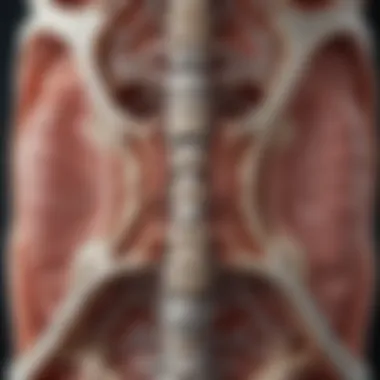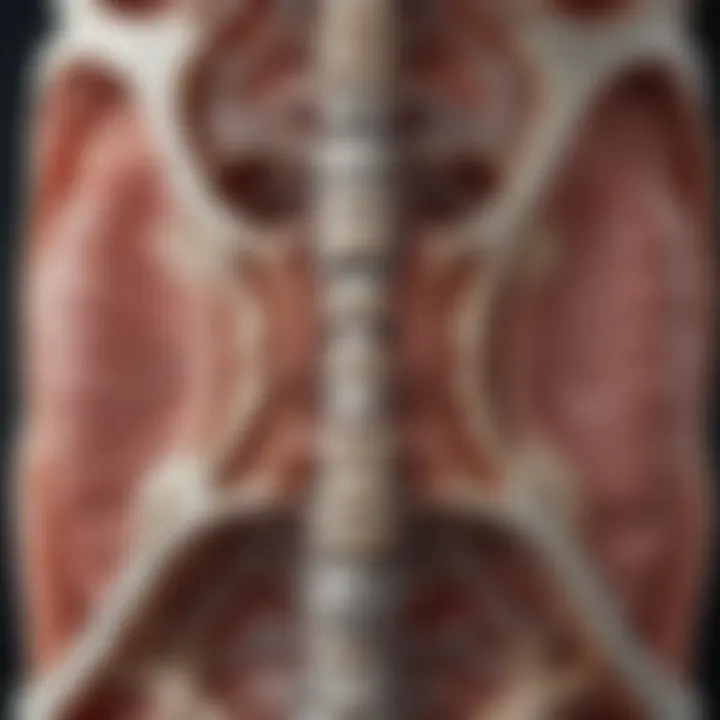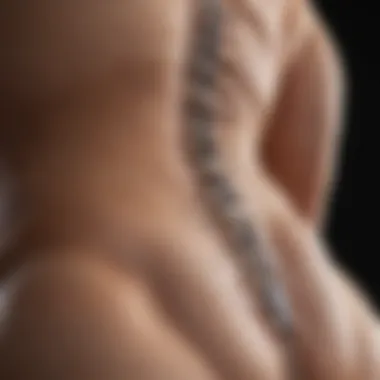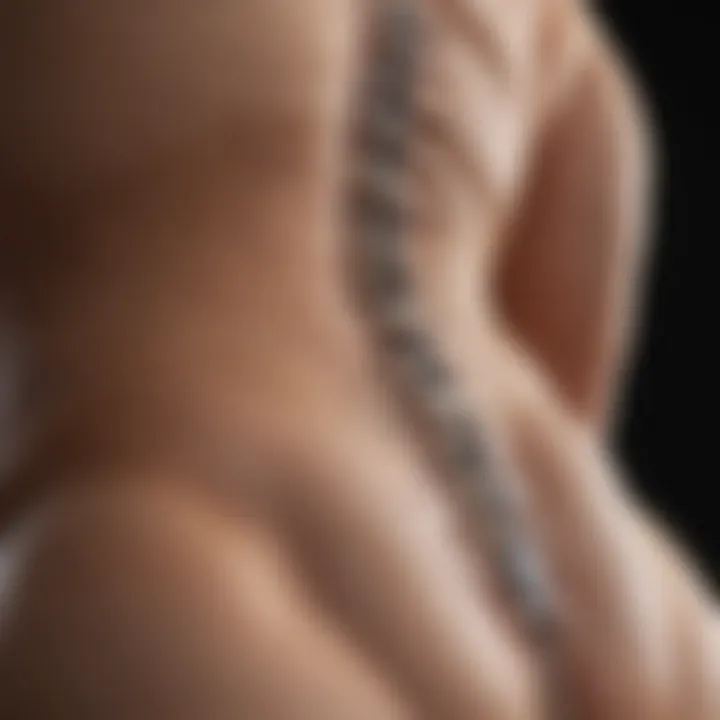Understanding Retrolisthesis: Causes and Treatments


Intro
Retrolisthesis is a condition that affects the lumbar spine, drawing attention from both medical professionals and patients alike. Understanding this condition requires a thorough examination of its anatomical implications, clinical outcomes, and management strategies. As the healthcare sector increasingly emphasizes the importance of back health, retrolisthesis stands out for its unique biomechanical challenges and potential impacts on quality of life.
In this article, we will explore various facets of retrolisthesis, covering its causes, symptoms, diagnostic approaches, and treatment options. Additionally, we will look into prevention strategies to minimize the risk of developing this condition. Our goal is to provide a comprehensive guide aimed at students, researchers, educators, and healthcare professionals.
By dissecting complex medical information into digestible sections, we hope to enhance the understanding of retrolisthesis and equip readers with the necessary knowledge to address this condition more effectively.
Research Overview
Key Findings
Recent studies indicate that retrolisthesis is often associated with degenerative disc disease, traumatic injuries, or congenital anomalies. Key findings from the literature suggest the following points regarding prevalence and implications:
- Retrolisthesis may present in a significant portion of individuals experiencing low back pain.
- The severity of retrolisthesis correlates with the degree of associated symptoms, often determining treatment protocols.
- Diagnostic imaging plays a crucial role in assessing the extent and impact of retrolisthesis on spinal functionality.
Study Methodology
Research on retrolisthesis typically involves both retrospective and prospective studies. Methods commonly include:
- Radiological evaluations to assess spinal alignment and mobility.
- Clinical assessments to gather patient history and symptomatology.
- Comparative studies between different treatment modalities to evaluate efficacy.
Such methodologies aim to enrich the understanding of retrolisthesis and promote evidence-based interventions.
Background and Context
Historical Background
The recognition of retrolisthesis dates back several decades, with initial descriptions emerging from studies on spinal alignment. Health care providers have gradually developed a clearer understanding of this condition.
Research has transitioned from merely identifying retrolisthesis to exploring its underlying causes and resulting symptoms. Increased diagnostic capabilities evolved, allowing for improved identification via advanced imaging techniques.
Current Trends in the Field
In contemporary settings, there is a noticeable increase in awareness surrounding retrolisthesis and its implications. Current trends include:
- A holistic approach to treatment, integrating physical therapy, medication, and, in some cases, surgical interventions.
- The promotion of preventive strategies, emphasizing the need for ergonomic practices and lifestyle adjustments.
The intersection of research and clinical practice continues to reveal new insights regarding retrolisthesis. This evolving landscape fosters a need for ongoing education for healthcare professionals.
Understanding retrolisthesis not only assists in managing pain but also addresses potential long-term complications that can arise if left untreated.
Preface to Retrolisthesis
Understanding the condition of retrolisthesis is pivotal in the field of spinal health. This condition occurs when a vertebra shifts backwards in relation to the adjacent vertebra below it. It's essential to grasp not only what retrolisthesis is but also its implications for patient well-being and the broader medical community. With a solid comprehension of this disorder, practitioners can better assess and treat individuals affected by it.
Definition of Retrolisthesis
Retrolisthesis is defined as a posterior displacement of a vertebra. This displacement can lead to various degrees of spinal instability and may result in discomfort or pain. The shift is not always a result of a single incident; factors like degeneration, trauma, or congenital defects may contribute to its development. Retrolisthesis can occur at any level of the spine, though it is most commonly seen in the lumbar region.
The degree of retrolisthesis varies widely. In some cases, the vertebra may shift minimally, causing few symptoms. In others, significant displacement may lead to neurological issues arising from nerve compression. Accurate identification and understanding of this condition are essential for effective treatment strategies.
Differences Between Retrolisthesis and Other Spinal Disorders
It is crucial to differentiate retrolisthesis from similar spinal disorders such as spondylolisthesis and other forms of spinal misalignment. While retrolisthesis involves a backward shift of a vertebra, spondylolisthesis refers to the forward slippage of a vertebra over another. Both conditions can result from similar causes, yet they require distinct treatment approaches.
Moreover, unlike scoliosis, which involves lateral curvature of the spine, retrolisthesis specifically pertains to the positioning of vertebrae along the sagittal plane. These differences are not merely academic; they underline the importance of precise diagnosis and tailored treatment plans.
Understanding these distinctions provides clarity in both clinical assessment and therapeutic decisions. A deeper awareness of retrolisthesis and how it contrasts with other disorders enables better management and outcomes for impacted patients.
Anatomical Considerations
Understanding the anatomical foundation of the lumbar spine is crucial for comprehending retrolisthesis. This condition involves a displacement of vertebrae in relation to one another. To manage retrolisthesis effectively, one must appreciate the structural components and their interrelations. The lumbar region consists of five vertebrae known as L1 to L5. They are the largest vertebrae, providing support for the upper body while allowing a significant range of motion. The anatomical characteristics of these vertebrae influence their stability and susceptibility to conditions like retrolisthesis.


Lumbar Spine Anatomy Overview
The lumbar spine is designed to endure various forces and loads placed upon it. The vertebrae are separated by intervertebral discs that act as shock absorbers. Each lumbar vertebra has a unique shape that contributes to the overall stability.
- Vertebral Body: Supports weight and absorbs impact.
- Spinous Process: Located at the back of each vertebra, serves as an attachment point for muscles and ligaments.
- Facet Joints: Pair of small joints situated between adjacent vertebrae, allows for movement and provides stability.
The sacrum acts as a base for the lumbar spine. Its unique position enhances load distribution across the pelvis and lower body. The lumbar lordosis, or the natural curve of the lower back, is fundamentally important. It facilitates efficient movement and load-bearing. Any disruption in this curvature can lead to spinal conditions, including retrolisthesis.
Biomechanics of Spinal Movement
The biomechanics of the lumbar spine are central to understanding how retrolisthesis arises. Movement in the lumbar region occurs primarily through three planes: flexion, extension, and rotation. Understanding these movements helps identify potential causes of retrolisthesis.
- Flexion: Bending forward, which compresses the intervertebral discs and alters the positioning of vertebrae.
- Extension: Bending backward, creates tension in the ligaments and may lead to misalignment if the support structures fail to function optimally.
- Rotation: Twisting movements that can affect the stability of the lumbar vertebrae, particularly in conjunction with flexion or extension.
In summary, the anatomical and biomechanical characteristics of the lumbar spine play a significant role in the development and manifestation of retrolisthesis. Recognition of these elements is key for anyone studying spinal disorders, as they lay the groundwork for further exploration into etiology, diagnosis, and treatment.
Etiology of Retrolisthesis
Understanding the etiology of retrolisthesis is crucial for several reasons. First, it provides insight into how different factors contribute to the condition. Recognizing these elements helps in developing targeted prevention and treatment strategies. Moreover, a comprehensive grasp of the origins of retrolisthesis allows healthcare professionals to identify at-risk populations and tailor interventions accordingly. Addressing the cause can often lead to improved patient outcomes.
Traumatic Factors
Trauma is one of the primary contributors to the development of retrolisthesis. Various types of injuries can lead to displacement in the lumbar vertebrae. For example, traumatic incidents such as falls, sports injuries, or motor vehicle accidents might exert significant force on the spine. Such impacts can disrupt the normal alignment of the vertebrae, resulting in a condition where one vertebra slips backward relative to the adjacent vertebra. The severity of trauma and the specific vertebrae involved can determine the extent of the retrolisthesis and influence the patient's symptoms.
Degeneration and Aging
Degenerative changes account for a substantial number of retrolisthesis cases, particularly as individuals age. As the spine undergoes the natural aging process, the intervertebral discs lose hydration and elasticity. This degeneration can lead to disc height reduction, allowing for increased mobility between the vertebrae. Consequently, the vertebra may shift backward, leading to retrolisthesis. Beyond disc degeneration, other spinal components, such as ligaments and facet joints, can also weaken or become arthritic over time. This multifactorial process of aging thus increases the risk of spinal instability.
Congenital Conditions
Some individuals may be predisposed to retrolisthesis due to congenital conditions. These conditions can include abnormalities in the formation of vertebrae or discrepancies in the structural alignment of the spine. For example, conditions like spina bifida or scoliosis can create a predisposition for retrolisthesis by affecting overall spinal mechanics. Recognizing such congenital factors is vital for a deep understanding of an individual's risk profile when assessing spinal health.
As identified, each causative element plays a significant role in the presentation and management of retrolisthesis.
In summary, the etiology of retrolisthesis encompasses a range of factors—traumatic, degenerative, and congenital. Understanding these can improve diagnostic accuracy and inform effective treatment plans.
Clinical Presentation
Understanding the clinical presentation of retrolisthesis is essential because it highlights the various ways this condition can manifest. Recognizing symptoms is crucial for proper diagnosis and management. Each patient's experience can differ markedly based on the severity and duration of the condition. Identifying symptomatic manifestations and understanding when cases are asymptomatic provides important insight for healthcare providers.
Symptomatic Manifestations
Retrolisthesis can present with various symptoms that stem from nerve root compression or spinal instability. Common symptoms include:
- Lower back pain: This is the most frequently reported symptom. The pain can be sharp or dull and may radiate into the buttocks or legs. It often worsens with certain movements or prolonged positions.
- Radicular pain: Patients might also experience pain that radiates along the pathway of a particular nerve. This occurs when a nerve root is compressed.
- Muscle weakness: There may be some degree of weakness in the lower limbs, which could hinder mobility.
- Numbness or tingling: Patients may report sensations of tingling or numbness, often in areas that correspond to the affected nerves.
- Limited range of motion: Individuals often find it hard to bend or twist, impacting day-to-day activities significantly.
The pathophysiology behind these symptoms can involve a myriad of factors including mechanical instability and inflammatory responses. Healthcare practitioners must consider these when diagnosing retrolisthesis and forming treatment plans.
Asymptomatic Cases
Interestingly, some individuals may have retrolisthesis but experience no symptoms whatsoever. These asymptomatic cases can be identified incidentally during imaging studies conducted for unrelated issues.
Several factors contribute to these asymptomatic presentations:
- Degree of slip: Minor displacements may not provoke symptoms, as the surrounding muscles and ligaments stabilize the spine adequately.
- Adaptability of the body: In some cases, the body may adapt well to spinal deformities over time, leading to compensatory mechanisms that reduce pain.
- Lack of nerve involvement: Absence of nerve compression or irritation allows individuals to remain symptom-free.
Understanding these asymptomatic cases is important for healthcare professionals. It emphasizes the need for a tailored approach to diagnosing and treating retrolisthesis. Educating patients about their condition, whether symptomatic or not, can help them make informed decisions about their health.
Diagnostic Approaches
The diagnosis of retrolisthesis is a critical step towards understanding the condition and determining appropriate treatment. Accurate diagnostic techniques help identify the presence and severity of spinal misalignments. They also assist in distinguishing retrolisthesis from other spinal disorders. Incorporating a wide range of methods enables healthcare professionals to build a comprehensive picture of a patient's spinal health.
Imaging Techniques


X-ray Assessment
X-ray assessment is often the first imaging study performed to detect retrolisthesis. This method provides a clear view of the lumbar spine and allows practitioners to visualize the alignment of the vertebrae. The clarity of the images can reveal any displacement or shift in the spinal column, making it easier for doctors to identify the condition quickly. One notable characteristic of X-rays is their accessibility and efficiency; they are widely available and can be performed in various clinical settings.
However, they do have limitations. X-rays provide only a two-dimensional view of a three-dimensional structure. This means that subtle misalignments may be missed. Additionally, X-rays are not able to display soft tissue structures like discs or nerves, which makes it essential to consider complementary imaging techniques. Despite these drawbacks, the quick results from X-rays often make them a first-choice option for practitioners assessing lumbar spine disorders.
MRI and CT Utilization
MRI and CT scans are advanced imaging modalities that provide detailed images of both bony and soft tissue structures in the lumbar spine. These techniques are instrumental in evaluating retrolisthesis more accurately. MRI is particularly effective in visualizing intervertebral discs, epidural spaces, and other soft tissues, which offers valuable information that X-rays cannot provide. This is an important benefit, especially when planning treatment strategies that may involve nerves or soft tissues affected by retrolisthesis.
CT scans, on the other hand, combine the merits of both X-ray and MRI, offering high-resolution images of bone and soft tissue. They are especially useful in complex cases where bone anatomy needs to be assessed in great detail. However, CT scans expose patients to higher radiation levels compared to X-rays, making them less preferable for routine evaluations.
Both MRI and CT have their unique features that make them valuable in a clinical setting. The choice between them often depends on the specific needs of the evaluation and the clinical scenario presented.
Clinical Evaluations
Clinical evaluations are another crucial component of the diagnostic approach to retrolisthesis. These evaluations typically encompass a thorough patient history, physical examinations, and specific neurological assessments. During the clinical evaluation, healthcare providers can identify symptoms more accurately and assess the impact of retrolisthesis on a patient’s overall function. This combination of diagnostic tools creates a robust framework for understanding the condition and planning appropriate management strategies.
"Effective diagnosis of retrolisthesis requires a harmonious blend of imaging techniques and clinical assessments."
In summary, diagnostic approaches play an essential role in managing retrolisthesis. By understanding the strengths and limitations of each method, clinicians can provide a more informed and comprehensive care approach.
Treatment Options
Treatment options for retrolisthesis are vital in managing the condition effectively. Treatment pathways can vary significantly based on the severity and symptoms of the disorder. It is crucial to identify the most appropriate methods to enhance recovery and improve quality of life. Both non-surgical and surgical interventions play significant roles in the treatment landscape, with an emphasis on tailored approaches for individual patients.
Non-Surgical Treatments
Physical Therapy
Physical therapy is a cornerstone of non-surgical interventions for retrolisthesis. It aims to strengthen the muscles surrounding the spine, improving stability and mobility. One of its key characteristics is the development of a customized exercise program based on the patient's specific needs. This aspect makes it a beneficial choice. The unique feature of physical therapy lies in its holistic approach to treatment. Therapists not only focus on exercise but also educate patients about body mechanics and posture correction. The advantages include improved function and reduced pain without resorting to more invasive procedures. However, one possible disadvantage is that results can be gradual and require sustained commitment from the patient.
Pain Management Strategies
Pain management strategies are essential for individuals dealing with the discomfort associated with retrolisthesis. These strategies often include medications, such as non-steroidal anti-inflammatory drugs (NSAIDs), and injections to manage pain effectively. A key characteristic here is the focus on providing immediate relief, which can enhance a person's ability to engage in other therapeutic activities, including physical therapy. The unique feature of these strategies is their variety, allowing for a customized plan that suits the specific pain profile of the patient. Advantages include quick relief, while disadvantages might involve side effects or dependency on medications over time.
Chiropractic Care
Chiropractic care focuses on spinal alignment and adjustment. This aspect makes it a popular option for patients with retrolisthesis seeking non-surgical intervention. The treatment usually involves manual manipulation aimed at restoring proper function and reducing pain. One of the benefits of chiropractic care is that it often results in immediate pain relief and improved mobility. However, it is important to note that while many people find this approach effective, it may not address the underlying causes of retrolisthesis, which means patients might need to combine chiropractic treatment with other therapies.
Surgical Interventions
Laminectomy
Laminectomy is a surgical procedure aimed at relieving pressure on the spinal cord or nerves by removing a portion of the vertebra called the lamina. This procedure is often considered when non-surgical interventions fail to provide sufficient relief. The key characteristic of laminectomy is its effectiveness in alleviating symptoms associated with nerve compression. A unique feature is that it can be performed on an outpatient basis, reducing hospital stays. Advantages include significant pain relief and improved mobility, although potential complications and a longer recovery time should be considered before opting for surgery.
Spinal Fusion Techniques
Spinal fusion techniques are employed to stabilize the spine after corrective procedures, including laminectomy or in cases of severe retrolisthesis. The goal of spinal fusion is to permanently connect two or more vertebrae, eliminating motion at that segment. A key characteristic of this approach is its potential to provide long-lasting stability. Its unique aspect is that it can significantly reduce pain levels as a result of better spinal alignment. However, disadvantages include a longer surgical recovery and the possibility of complications related to the fusion process.
"Selecting the right treatment option for retrolisthesis requires careful consideration of individual needs and health status."
In summary, both non-surgical and surgical treatment options provide various pathways to manage retrolisthesis. When choosing a strategy, factors like severity of symptoms, patient health, and personal preferences should guide the decision-making process to optimize outcomes.
Prognosis and Outcomes
The prognosis and outcomes of retrolisthesis in the lumbar spine are critical areas of study within understanding this condition. This section aims to elucidate the factors that influence recovery potential and the long-term management of patients suffering from retrolisthesis. By investigating these elements, we can better appreciate the varying degrees of recovery and the tailored approaches necessary for effective management.
Recovery Potential
Recovery potential in patients with retrolisthesis depends on multiple factors. Key elements include the severity of the condition, the age of the patient, and any concurrent health issues.
- Severity of the Condition: Patients with mild retrolisthesis often experience better outcomes compared to those with significant displacement.
- Age: Younger patients generally respond more favorably to conservative treatment than older patients, whose bodies may not adapt as easily.
- Associated Conditions: Comorbidities, such as arthritis or osteoporosis, can complicate recovery. Effective management may require addressing these factors alongside the retrolisthesis.


Research indicates that those who adhere to prescribed rehabilitation protocols typically show marked improvement. A study published in relevant medical literature emphasizes the importance of early intervention. Non-surgical approaches such as physical therapy can often eliminate symptoms. However, in more severe cases, surgical options may be warranted.
"The success of treatment for retrolisthesis largely hinges on the individual's circumstances, highlighting the importance of personalized care."
Long-Term Management
Long-term management of retrolisthesis involves continuous assessment and adaptive strategies focused on maintaining spinal health.
- Regular Check-ups: Continuous monitoring is fundamental. Routine imaging and assessments allow healthcare providers to gauge the progression of the condition.
- Adapted Physical Activity: Patients should engage in low-impact exercises to improve core strength and flexibility. This can mitigate symptoms and potentially prevent further displacement.
- Education: Patients must understand the condition and its management strategies. Ongoing education ensures patients make informed decisions about their lifestyle and health choices.
- Pain Management: Chronic pain is a significant concern. Thus, a combination of medication, therapeutic interventions, and lifestyle adjustments may be necessary to provide relief without the need for ongoing invasive procedures.
In summary, the prognosis for retrolisthesis can vary significantly from one individual to another based on various factors. Patient-specific strategies are paramount for effective long-term management.
Preventative Measures
Preventative measures play a vital role in managing retrolisthesis of the lumbar spine. These strategies focus on reducing the likelihood of developing this condition and its associated complications. By focusing on proper ergonomics, lifestyle adjustments, exercise, and strengthening programs, individuals can actively contribute to their spinal health. The following subsections detail specific elements that can aid in prevention.
Ergonomics and Lifestyle Adjustments
Proper ergonomics is essential for minimizing strain on the lumbar spine. This involves assessing and modifying workspaces to ensure an optimal body posture. Here are some important considerations:
- Desk Setup: Adjust your chair and desk height. A chair that supports the lower back can reduce stress on lumbar vertebrae.
- Screen Position: Keep monitors at eye level to avoid tilting the head and neck forward, which can stress the spine.
- Breaks: Take regular breaks from prolonged sitting or standing. Engaging in simple stretches can relieve tension.
Lifestyle choices also play a crucial role in preventing retrolisthesis. Maintaining a healthy weight can alleviate excessive pressure on the spine. Avoiding smoking is key as it can affect blood flow and bone health.
Exercise and Strengthening Programs
A well-designed exercise program can be essential in strengthening the spinal support system, which includes muscles surrounding the lumbar spine. Strengthening core muscles reduces the risk of injury and maintains spinal alignment. Consider the following recommendations:
- Core Strengthening: Activities such as planks, bridges, and abdominal exercises strengthen the muscles supporting the spine.
- Flexibility Training: Incorporating yoga or stretches can enhance flexibility and reduce tension in the lumbar region.
- Low-Impact Aerobic Exercise: Activities like walking, swimming, and cycling promote overall spinal health without excessive impact.
"An ounce of prevention is worth a pound of cure."
Adopting these lifestyle changes can contribute to a healthier spine and possibly prevent retrolisthesis from becoming a significant issue.
Research and Future Directions
Research is integral for enhancing our comprehension of retrolisthesis. This condition, characterized by the backward displacement of a vertebra, can have complex implications for spinal health. Ongoing and future studies are essential to unravel various aspects, including etiology, effective treatment methods, and long-term outcomes. By prioritizing research, we aim to refine our understanding not only of the condition itself but also of how it impacts patient quality of life.
Emerging Studies
A number of recent studies focus on the multifaceted causes of retrolisthesis. Researchers explore connections between lifestyle factors, genetics, and environmental influences. For example, studies suggest that obesity could increase the risk of developing spinal disorders, including retrolisthesis. Important investigations also target the mechanical stresses placed on the lumbar spine, contributing to evidence-based preventive strategies.
Additionally, clinical trials involving conservative and surgical therapies are gaining momentum. These studies aim to assess the efficacy of physical therapy and novel medications in managing symptoms associated with retrolisthesis. As data accumulates, the scientific community can derive best practices for clinical settings.
Innovations in Treatment Protocols
Innovations in treatment protocols reflect the advancements in medical technology and understanding of spinal mechanics. Presently, minimally invasive surgical techniques offer promising alternatives to traditional methods. Such innovations include endoscopic decompression, which minimizes patient recovery time while effectively addressing spinal compression.
Moreover, the integration of personalized medicine has begun to influence treatment decisions for retrolisthesis. This approach considers genetic and biological factors unique to each patient, allowing for tailored treatment plans. For instance, ongoing research delves into the use of biological agents that may enhance spinal healing, suggesting a hopeful shift toward regenerative therapies in the management of spinal conditions.
Staying updated on these developments is crucial for healthcare providers, as it allows them to offer more effective patient care and improve outcomes.
Ending
The conclusion serves an essential role in synthesizing the discussions surrounding retrolisthesis of the lumbar spine within this article. It provides a cohesive summary that encapsulates the vital insights gleaned from various sections, offering clarity and reinforcing the reader's understanding of this complex condition. By highlighting the critical points discussed, such as the anatomical underpinnings, clinical presentations, and treatment approaches, this conclusion enables a comprehensive grasp of retrolisthesis. It ensures that both novice and experienced readers appreciate the multifaceted nature of this disorder in a succinct manner.
Moreover, understanding the implications of retrolisthesis is key for health professionals who may encounter patients suffering from it. This knowledge empowers them to make informed decisions regarding diagnosis and treatment. The inclusion of preventative measures and future directions in research additionally addresses the importance of proactive management and innovation in care practices. Thus, the conclusion not only reiterates significant information but also underscores the ongoing need for awareness and education about retrolisthesis in the medical community.
Summary of Key Points
In summary, the article has covered several critical aspects of retrolisthesis:
- Definition and Understanding: Retrolisthesis is characterized by posterior displacement of a vertebra in relation to the one below it.
- Clinical Presentation: Symptoms can vary significantly, with some individuals being asymptomatic while others experience significant pain.
- Diagnostic Approaches: Advances in imaging techniques, such as MRI and CT scans, enhance diagnostic accuracy.
- Treatment Modalities: Options range from non-surgical methods like physical therapy to surgical interventions when necessary.
- Prognosis: While many individuals can recover with appropriate treatment, long-term management is often required to prevent recurrence.
- Preventative Measures: Practicing good ergonomics and engaging in strengthening programs can help mitigate further risks.
These points emphasize the condition's complexity and the importance of a multidisciplinary approach to treatment and management.
Final Thoughts on Retrolisthesis
Retrolisthesis must be understood in both a clinical and educational context. As healthcare professionals and researchers continue to explore this condition, they contribute to advancing knowledge and improving patient outcomes. The array of treatment options available illustrates that while retrolisthesis can lead to significant discomfort, there are effective strategies for management.
Furthermore, with the rise of emerging studies and innovative protocols, there is hope for enhanced understanding and treatment of retrolisthesis. The path forward will likely involve a combination of traditional methods and cutting-edge research to address this lumbar spine issue effectively. Overall, sustaining a focus on education, awareness, and ongoing research will be crucial in addressing the complexities associated with retrolisthesis and enhancing the quality of life for affected individuals.







